Regional News
Cambodia Counters Thai Border Claims at the Hague Netherlands
THE HAGUE, Netherlands – The International Court of Justice opened hearings on the Preah Vihear, a 900-year-old Hindu temple over which Cambodia and Thailand have fought bitterly.
The hearings at the United Nations’ highest court at The Hague, Netherlands, were sought by Cambodia after the court ordered the troops of both countries to withdraw after their deadly clashes in April 2011 left several people dead and forced several thousands more in the region to flee.
Thailand is also seeking to play down the relevance of the French map compared to its own maps of the region.Cambodia began four days of hearings at the International Court of Justice (ICJ) yesterday by insisting on the country’s very right to ask the U.N.’s top court to settle the deadly dispute with Thailand over hotly contested land next to Preah Vihear temple.
At stake is a 4.6 square km tract of land next to the temple over which Thailand and Cambodia have fought several brief but lethal clashes since 2008, when Thailand failed to stop Cambodia’s bid to list the 10th-century sanctuary as a world heritage site.
Amid the mounting death toll, Cambodia turned to the ICJ in April 2011, just two months after the heaviest bout of fighting around Preah Vihear, to settle the matter for good by interpreting a 1962 decision by the ICJ in which the court awarded Cambodia the Preah Vihear temple, and its “vicinity.”
Thailand maintains that the 1962 ruling made no determination regarding the land around the temple.
Delivering his opening remarks in French at The Hague, Foreign Minister Hor Namhong said Cambodia had no choice but to file the request to the court back in 2011.
“Why is Cambodia coming back after 50 years?… It is the necessity that we felt absolutely imposed upon us,” the foreign minister said. “This necessity results, as you will be well aware, from acts of arms from Thailand,” he said.
Accusing Thailand of trying to play down the military clashes at the temple and elsewhere along the border, Mr. Namhong said, “Thailand would wish that this be forgotten.”
Cambodia is asking the ICJ to “interpret” the decision it handed down in 1962, which awarded the Preah Vihear temple to Cambodia on the basis of a colonial-era French map that placed it on the Cambodian side of the then-border. Because Thailand had not objected to that map for most of the previous half-century, the court decided, it had effectively accepted the boundaries.
The spectacular temple atop a 1,772-foot cliff was inscribed on the World Heritage List in 2008Though the 1962 decision did not specifically rule on the now-disputed land beside the temple, the ICJ did order Thailand to withdraw from the temple’s “vicinity.” And by that, Cambodia argues, the court clearly meant everything on the Cambodian side of the French map, which includes the 4.6 square km now being contested.
Thailand argues that the ICJ has no jurisdiction to interpret the 1962 decision because Cambodia is actually asking for more than an interpretation, and because the two countries never actually disagreed on how to interpret the 1962 decision in the first place. Thailand is also seeking to play down the relevance of the French map compared to its own maps of the region.
Cambodia’s team of international lawyers started picking Thailand’s claims apart at The Hague yesterday.
“Both argument are fallacious and both argument are beside the point,” said Franklin Berman, an Oxford University law professor, speaking on behalf of Cambodia.
While ICJ rules generally discourage interpreting an old decision, Mr. Berman said, they made a clear exception when interpretation was “inseparable from the operation part” of the 1962 decision, in this case the order for Thailand to withdraw from Preah Vihear temple’s “vicinity.”
“And that is the case here,” Mr. Berman told the court.
He then attacked Thailand’s claim that there was no need to interpret the 1962 decision because it was crystal clear on what the temple “vicinity” was.
Mr. Berman brought up a Thai government document from 1962, declassified only in 2011 and provided to the court in 2012, in which Thailand itself debated what area it was meant to withdraw from and put forward two options. Both those options placed the disputed 4.6 square km in Thailand.
“This is pure interpretation; what else could it be?” Mr. Berman said, and proved Cambodia’s point “that there can be no implementation without interpretation.”
Mr. Berman also called “ludicrous” Thailand’s efforts to use its own maps—with its own proposed national borders—to interpret the temple’s “vicinity” instead of the French map the ICJ used in its original decision and referred to in its reasoning in 1962.
“What else is the reasoning in a reasoned judgment for?” he asked.
As for Thailand’s claim that Cambodia had never officially objected to its interpretation of the 1962 decision, American lawyer Rodman Bundy reeled off a list of documents and reports clearly recording Cambodia’s protests to Thailand from the start.
“It’s extraordinary,” Mr. Bundy said of Thailand’s claim. “The facts, Mr. President, identify precisely the opposite.”
French lawyer Jean-Mark Sorel wrapped up the day’s hearing by attacking Thailand’s claim that the original decision was meant to settle a territorial dispute and not a boundary dispute, and so could not now settle the dispute over the 4.6 square km.
Mr. Sorel argued that the court could not settle the territorial dispute—who own Preah Vihear temple—without stating where that territory starts and ends. Settling the territorial dispute, he said, “leads directly to that boundary being established.”
He argued that the court in 1962 would never have deliberately left the boundary between the two countries unsettled. More likely, he said, the court thought the boundary issue was settled by the French map—which Thailand had effectively accepted—and so felt no need to spell it out in ordering Thai troops to leave the temple’s vicinity.
“That’s what seems the most probable to Cambodia,” he said.
After a break in hearings today, Thailand will make its case before the ICJ on Wednesday. Cambodia and Thailand will then have one more day each on Thursday and Friday, respectively.
As the hearing got under way at The Hague, Cambodian troops stationed near the temple said they were busy celebrating the Khmer New Year, which started Sunday and ends on Wednesday.
“It is quiet here,” said Lieutenant General Srey Doek, Intervention Division 3 commander of the Royal Cambodian Armed Forces based in Preah Vihear, dismissing reports of a troop buildup around the talks.
“Our troops are celebrating Khmer New Year,” he said. “We take turns. Some visit their families and some go to the pagoda.”
Thailand and Cambodia withdrew their troops from a demilitarized zone the ICJ created around the temple and disputed area in July, though it remains unclear whether either has complied fully with the order.

Regional News
Thai Immigration Police Detain Over 26,000 Illegal Migrant Workers
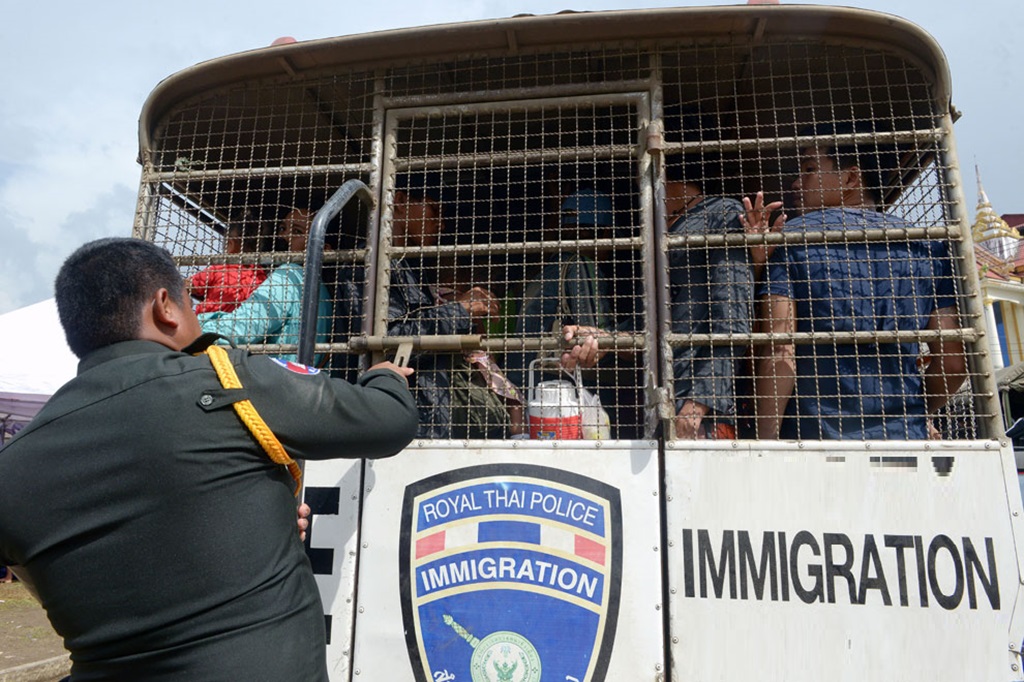
Thailand’s Immigration Police have detained approximately 26,000 illegal migrant workers from Laos, Myanmar, and Cambodia during an eight-day operation in Bangkok and surrounding regions, according to a Royal Thai Police spokesperson.
Mr Adisorn Keudmeuangkhon of the Bangkok-based Migrant Working Group said the drive was in response to an increasing number of concerns about an influx of illegal migrant labor.
“Some Thai people see that many illegal workers are competing for their job positions in the past few months,” he told me. “That’s why the ministry has to take tougher action.”
Civil strife in Myanmar and the recent implementation of a military conscription have driven thousands of Burmese into Thailand, while severe inflation and limited job opportunities in Laos have also encouraged an influx of workers from that country.
Between June 5 and 12, officials detained and checked 20,111 Myanmar laborers, 1,659 Laotian migrant workers, and 3,971 Cambodian workers, according to the Ministry of Labor.
It marked the start of a 120-day campaign to audit workplaces and arrest unlawful migrant workers, according to the government.
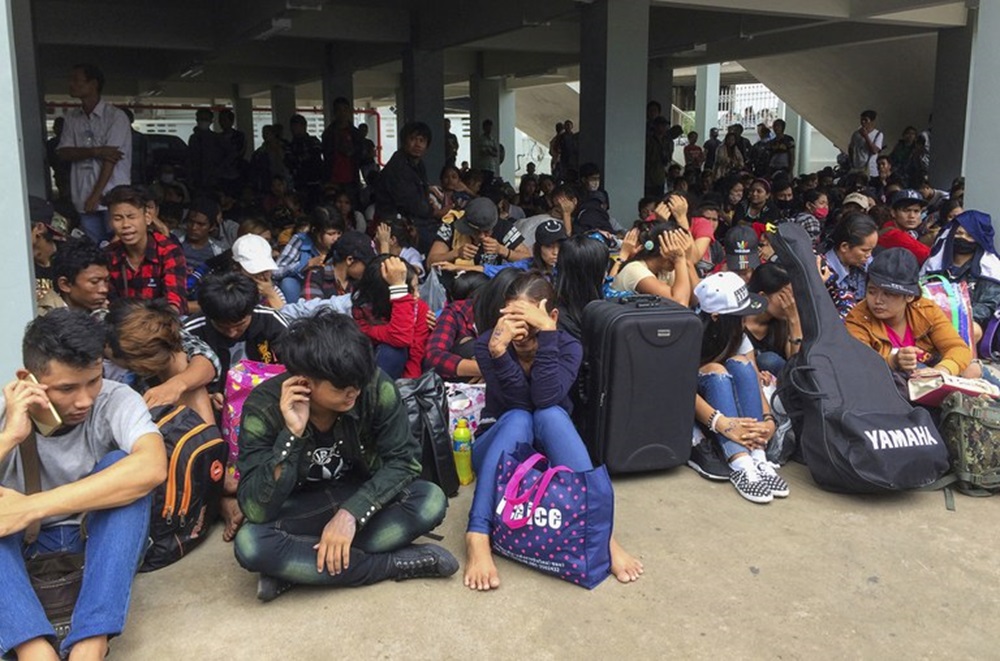
Migrant Workers to be Deported
According to Keudmeuangkhon, undocumented workers face fines ranging from 5,000 to 50,000 Thai baht (US $136 to $1,365), deportation, and a two-year prohibition on re-entering Thailand.
Authorities did not intend to file criminal charges, he claimed.
Authorities raided 1,774 workplaces, according to Moe Gyo, chairman of the Joint Action Committee on Burmese Affairs, which advocates for Myanmar labor rights.
He stated that since the military junta activated conscription, there has been an upsurge in the number of arrests of Myanmar citizens in Thailand who do not have a work permit identity card.
All men aged 18 to 35 and women aged 18 to 27 must serve in the military for at least two years. The first group of 5,000 conscripts summoned by Myanmar’s junta will start duty at the end of this month, military sources told AFP on Monday.
According to Keudmeuangkhon, the bulk of Lao migrant workers in Thailand work as fresh market shopkeepers, restaurant servers, and mall salespeople.
Most people visit Thailand as part of ASEAN’s visa-free policy for tourists, but they stay longer than the 30-day restriction once they find job.
“Employers like to hire Lao migrant workers in the service sector because they can speak fluent Thai,” he told me.
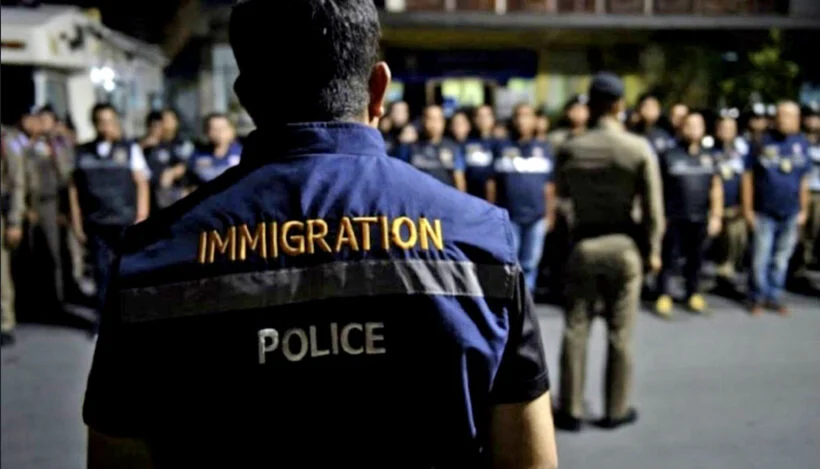
Immigration Police Detain Illegal Migrant Workers
The Thai Cabinet may approve an enhanced program for Thai employers to register their unauthorized foreign workers in July or August. Keudmeuangkhon explained.
Last month, the Thai Ministry of Labor’s Foreign Workers Administration office announced that 268,465 Lao migrant workers were officially working in Thailand.
Baykham Kattiya, Lao Minister of Labor, told Radio Free Asia earlier this month that there are 415,956 migrant workers in other nations, the majority of whom work in Thailand.
According to her, the Lao government believes that over 203,000 persons working outside of the nation lack proper work documents.
However, a Lao official familiar with the labor industry informed Radio Free Asia, a BenarNews-affiliated news station, on June 20 that the number of illegal Lao migrant workers in Thailand and abroad is likely significantly greater.
“They go to other countries as illegal migrant workers through different types of methods – as tourists or students,” said the politician. “Thus, it is hard for the immigration police to collect data on these people.”
Government Officials Responsible for Smuggling in Migrant Workers
Government Officials Responsible for Smuggling in Migrant Workers
News
High School Student Dies After Being Electrocuted By School Water Dispenser
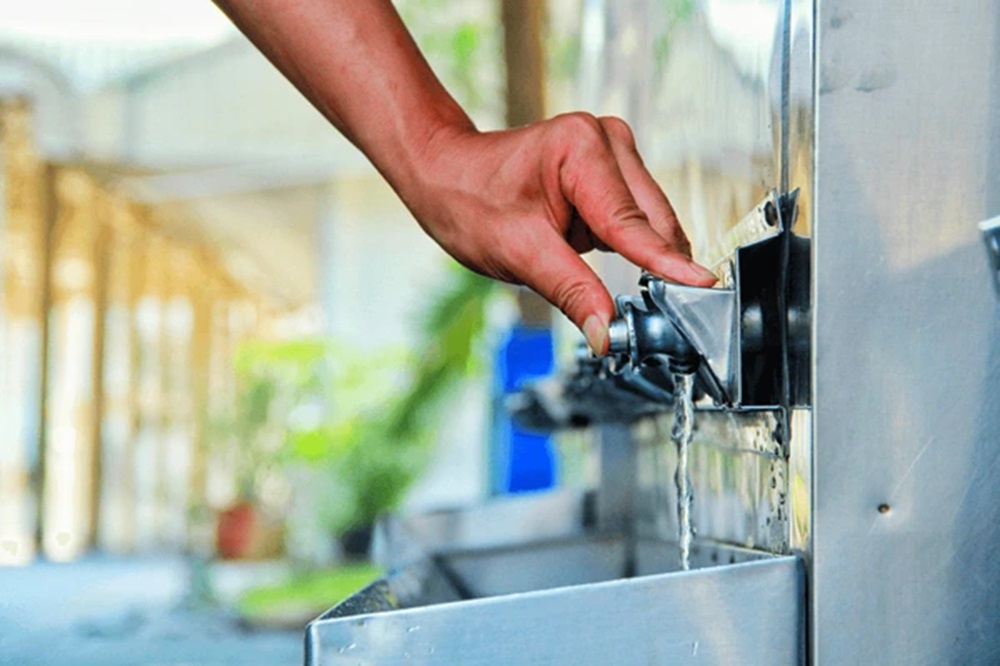
Thailand’s Office of Basic Education Commission has initiated an investigation into the electrocution of a 14-year-old student by a water dispenser in a high school. The event happened at noon on Friday, during the high school’s sports day. The victim was a Grade 8 student.
According to local media in Trang Province, the incident occurred when a teacher instructed the pupil to turn off a water dispenser amid a heavy rain.
According to a witness, the child collapsed while strolling with his friend near a water station. The friend claimed he attempted to assist but was also shocked by electricity.
According to reports, the friend then recovered, left the site, and requested assistance from teachers. A teacher ran to the scene and used a towel to pull the boy away by the ankle. He was taken to the hospital, but it was too late, they claimed.
The event sparked criticism from parents and netizens over school safety, as well as the slow response to aid the young youngster.
Mr. Chainarong Changrua, head of Trang-Krabi’s Secondary Educational Service Area Office, told local media on Sunday that forensic officers from Trang Provincial Police had visited the area. They discovered the blown breaker switch behind the water dispenser, he explained.
The breaker was burned out, thus the authorities assumed the disaster was caused by a short circuit that allowed energy to spill to a neighboring power pole. The student also appeared wet and was not wearing shoes when electrocuted.
According to the Office of Basic Education Commission, a probe team will complete its investigation this week.
The student’s father, Mr Pornchai Thepsuwan, 53, claimed he was saddened when he saw his son’s body. The boy (Wayu), was the youngest of two boys, he explained. He stated that following the tragedy, the school director and staff gave financial assistance to the families.
Mr Pornchai also said he would not seek charges against the institution because he believed it was an accident.
Electrical accidents in Thailand
Electrocution instances in Thailand have increased alarmingly in recent years. Many mishaps occur as a result of improper wiring and inadequate maintenance of electrical systems.
Public locations, such as schools and markets, frequently lack adequate safety precautions, putting individuals in danger. In rural areas, antiquated infrastructure exacerbates the situation, resulting in more frequent and serious events.
Although several high-profile cases have brought these challenges to light, genuine progress has been gradual. Furthermore, the rainy season heightens the likelihood of electrical accidents, as water and exposed wires do not mix well.
The government has made steps to strengthen safety standards, but enforcement is patchy. More education on electrical safety could help to reduce these accidents.
Unfortunately, better infrastructure and tougher rules may have prevented many of these incidents. The loss and injuries caused by electrocution are avoidable, emphasizing the need for immediate action.
Over 200 High School Students Facing Sedition Charges in Thailand
Over 200 High School Students Facing Sedition Charges in Thailand
News
Thailand’s Tourist Police Crackdown on Tourist Scammers in Pattaya
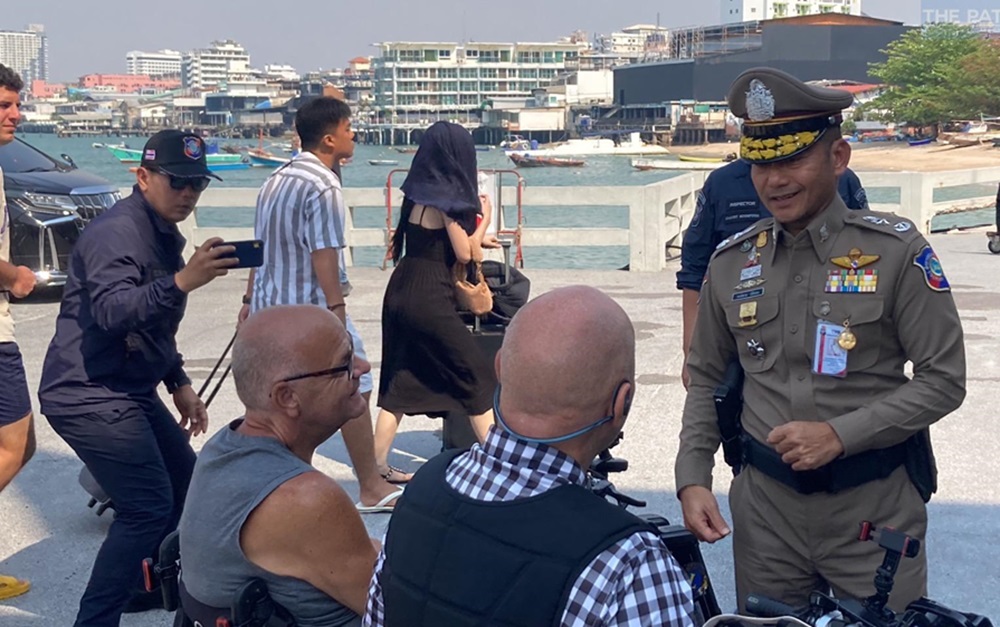
Thailand’s Tourist Police said it is collaborating with embassies from five countries to combat tourist scams and ten criminal gangs in Pattaya. The Tourist Police Bureau, convened a meeting on Thursday Pol Lt Gen Saksira Phuek-am told a press briefing.
Pol Lt Gen Saksira Phuek-am, the Tourist Police bureau commissioner said the participants included ambassadors from South Korea, Ukraine, Russia, India, and Switzerland.
He told the briefing the he had ordered a crackdown on tourist frauds, such as fraudulent or low-quality tour operators and unfair sales of goods and services. Stepped-up operations began on June 19 and will continue until June 25.
He stated that the agency was working with numerous organisations to increase tourists’ confidence in visiting Pattaya.
Gen Saksira spent time on the famed Walking Street speaking with officers on duty and assigned them to seek for members of ten criminal groups known to operate in Pattaya.
Meanwhile, Prime Minister Srettha Thavisin will visit Chon Buri on Saturday to assess the tourism situation. He intends to visit the site of a future Formula One racecourse near Khao Phra Tamnak in Bang Lamung District.
Prime Minister Srettha recently met with Formula One organisers in Italy to examine the potential of including Thailand on the race schedule in the future.
On Sunday, the Prime Minister will pay a visit to Rayong’s U-tapao airport to discuss development on the airport’s land, with the goal of encouraging investment in the Eastern Economic Corridor.
Police Chief Reinstated
In other police news, Pol Gen Torsak Sukvimol has been reinstated as national police chief following the conclusion of an investigation into a highly publicised quarrel, according to Wissanu Krea-ngam, Prime Minister Srettha Thavisin’s counsellor.
Mr Wissanu released the investigation’s findings on Thursday, after the prime minister formed a fact-finding committee chaired by Chatchai Promlert to investigate into the quarrel between Pol Gen Torsak and his deputy, Pol Gen Surachate Hakparn.
The four-month study revealed conflicts and disorder at all levels of the Royal Thai Police, but it was unclear whether these issues arose from a single cause or several causes, according to Mr Wissanu.
The findings revealed that both Pol Gen Torsak and Pol Gen Surachate were involved, with each team contributing to the tensions, he noted.
Mr Wissanu indicated that Pol Gen Surachate was reinstated as deputy national police head on 18 April following his relocation to the Prime Minister’s Office on 20 March. A disciplinary committee was formed to investigate Pol Gen Surachate, and he was ordered temporarily suspended from the police force.
Because there were no further difficulties to explore, it was decided to restore Pol Gen Torsak. He plans to retire on September 30.
On March 20, Mr Srettha abruptly transferred both top police officers to the Prime Minister’s Office in an effort to address the growing schism within the police service.
Kitrat Panphet, Deputy National Police Chief, was subsequently named Acting Police Chief. According to sources, Pol Gen Surachate could face money laundering charges related to online gaming networks.
Source: Bangkok Post
-

 News4 years ago
News4 years agoLet’s Know About Ultra High Net Worth Individual
-
Entertainment2 years ago
Mabelle Prior: The Voice of Hope, Resilience, and Diversity Inspiring Generations
-
News11 years ago
Enviromental Groups Tell Mekong Leaders Lao Dam Evaluation Process Flawed
-

 Health4 years ago
Health4 years agoHow Much Ivermectin Should You Take?
-

 Tech3 years ago
Tech3 years agoTop Forex Brokers of 2023: Reviews and Analysis for Successful Trading
-

 Lifestyles3 years ago
Lifestyles3 years agoAries Soulmate Signs
-

 Entertainment3 years ago
Entertainment3 years agoWhat Should I Do If Disney Plus Keeps Logging Me Out of TV?
-

 Health3 years ago
Health3 years agoCan I Buy Ivermectin Without A Prescription in the USA?